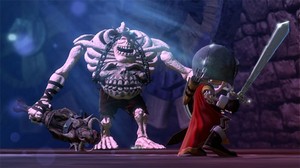
Make no mistake, this is a brand new PlayStation Move-exclusive title with its own characters and narrative, but at its core it's built upon the same fundamentals that developer Zindagi Games founded in last year's motion controlled sports compilation.
Our demo opens in a vast training arena. It's early evening, and the sun is setting upon the various dummies and equipment that is strewn around the environment. A whimsical narrator introduces us to the game's stumpy protagonist Edmund, and begins to explain the game's various mechanics.
And it's from the tutorial you realise just how much in common this game has with Sports Champions. From the calibration procedure, through to the on-screen demonstrations, it feels like a natural successor to the PlayStation Move launch title. And it controls familiarly too. Swinging Edmund's sword feels precise, just as it did in Sports Champions' gladiator mini-game. Hitting the Move button prompts Edmund to prop up his shield, allowing you to gesture the motion controller around your body in order to block incoming attacks.
The game feels surprisingly physical, as much of the combat is based on rebounds and parries. In order to block an incoming strike, you must bend your body down towards the ground in order to catch the attack. You're then able to counter with a powerful blow of your own, switching quickly between Edmund's sword and shield with deft use of the Move button.
But there's more to Deadmund's Quest than basic sword and shield combat. The game also boasts mid and long-range combat, in addition to traversal techniques, all of which are mapped very specifically to the motion controller. Edmund's mid-range attack is contributed by his shurikens, which can be accessed by holding the PlayStation Move controller like a Frisbee and clutching the T-button. If it sounds familiar, that's because it is — these are the same mechanics that were used in Sports Champions' disc-golf mini-game. Similarly, Edmund's bow-and-arrow covers any long-range requirements, allowing the stumpy character to attack distant enemies with a well placed projectile. Again, the mechanics are extremely Sports Champions-esque, with the weapon 'selected' by using the PlayStation Move controller to clutch at an imaginary quiver.
The tutorial level slowly but surely teaches us each of the mechanics in a fun manner. The game has us using our shield to block fruit, throwing shurikens at a batch of misplaced wooden crates, and firing arrows at moving targets. When the game is happy with our abilities, we're ushered into the first level: a winding castle environment which we must navigate to the top.
Visually Deadmund's Quest is stellar but, like Sports Champions, Zindagi's art direction is pretty weak. While the game is technically impressive — buoyed by strong lighting, high-quality textures and good character animation — the game looks generic. Stubby skeletons roam the castle waiting to attack, while Edmund himself is a poorly realised protagonist.
Sports Champions got away with its shoddy art-direction because the visuals played second fiddle to the unbelievably accurate motion mechanics. But with Deadmund's Quest adopting a more narrative driven approach, it would have been nice to see something a little more ambitious from Zindagi's art department this time around.
Thankfully the gameplay itself is rock-solid. While many will probably lament Zindagi's decision to adopt an 0n-rails experience, we couldn't help but notice the option to play with two PlayStation Move controllers in the game's calibration sequence. While we only got to experience the game with one motion controller, we imagine the action will be significantly enhanced with two.
Being on-rails the action does feel a bit rigid, with minimal option for exploration. The game occasionally pauses, allowing you to mop up an area of its collectible items, but otherwise you're restricted to a very specific path. What the game does well is mix up its enemy encounters. Sometimes skeletons will close in on you, requiring you to make use of your sword and shield. Other times they'll lumber slowly, allowing you to pick them off with a satisfying toss of a shuriken. And others will, of course, hide in the distance, requiring you to thwart them with a well-timed shot from your bow-and-arrow. It all feels satisfying and rewarding, and the action is enhanced by the sheer accuracy of the PlayStation Move. When you're in close-quarters combat, for example, using your sword and shield is visceral and exciting.
But at the same time, we're not sure how long the novelty is going to last. By the end of Medieval Moves' first level we felt exhilarated, but also ready to try something new. Hopefully the game manages to keep its mechanics feeling fresh, or it could become mightily repetitive spread across the length of an entire campaign.
Medieval Moves definitely shows signs of promise though. Sure the art direction is flat, but the game serves as a reminder of the PlayStation Move's potential to create strikingly precise motion mechanics. Switching between your sword and shield to off a throng of nearby foes is intense, and the excitement is heightened by your character's range of additional abilities. If Zindagi can find a way to keep the campaign feeling fresh, then Medieval Moves will definitely provide a worthwhile diversion until the inevitable Sports Champions 2.
Medieval Moves: Deadmund's Quest is set to release exclusively on PlayStation 3 in October. The game requires the PlayStation Move motion controller.





Comments 0
Wow, no comments yet... why not be the first?
Leave A Comment
Hold on there, you need to login to post a comment...